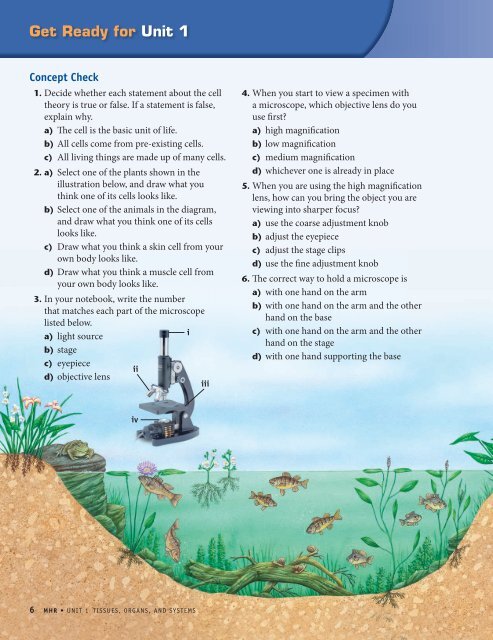Get Ready for Unit 1 (1754.0K) - McGraw-Hill Ryerson
Get Ready for Unit 1 (1754.0K) - McGraw-Hill Ryerson
Get Ready for Unit 1 (1754.0K) - McGraw-Hill Ryerson
You also want an ePaper? Increase the reach of your titles
YUMPU automatically turns print PDFs into web optimized ePapers that Google loves.
<strong>Get</strong> <strong>Ready</strong> <strong>for</strong> <strong>Unit</strong> 1<br />
Concept Check<br />
1. Decide whether each statement about the cell<br />
theory is true or false. If a statement is false,<br />
explain why.<br />
a) The cell is the basic unit of life.<br />
b) All cells come from pre-existing cells.<br />
c) All living things are made up of many cells.<br />
2. a) Select one of the plants shown in the<br />
illustration below, and draw what you<br />
think one of its cells looks like.<br />
b) Select one of the animals in the diagram,<br />
and draw what you think one of its cells<br />
looks like.<br />
c) Draw what you think a skin cell from your<br />
own body looks like.<br />
d) Draw what you think a muscle cell from<br />
your own body looks like.<br />
3. In your notebook, write the number<br />
that matches each part of the microscope<br />
listed below.<br />
a) light source<br />
i<br />
b) stage<br />
c) eyepiece<br />
ii<br />
d) objective lens<br />
iii<br />
4. When you start to view a specimen with<br />
a microscope, which objective lens do you<br />
use first?<br />
a) high magnification<br />
b) low magnification<br />
c) medium magnification<br />
d) whichever one is already in place<br />
5. When you are using the high magnification<br />
lens, how can you bring the object you are<br />
viewing into sharper focus?<br />
a) use the coarse adjustment knob<br />
b) adjust the eyepiece<br />
c) adjust the stage clips<br />
d) use the fine adjustment knob<br />
6. The correct way to hold a microscope is<br />
a) with one hand on the arm<br />
b) with one hand on the arm and the other<br />
hand on the base<br />
c) with one hand on the arm and the other<br />
hand on the stage<br />
d) with one hand supporting the base<br />
iv<br />
6 MHR • UNIT 1 TISSUES, ORGANS, AND SYSTEMS
Inquiry Check<br />
7. Brainstorm In your notebook, use a t-chart<br />
to list as many characteristics of single-celled<br />
and many-celled organisms as you can.<br />
Compare your list with a partner’s list.<br />
8. Evaluate The photo below shows a tea bag<br />
that has been sitting in boiled water <strong>for</strong> several<br />
minutes. Be<strong>for</strong>e the tea bag was placed in the<br />
water, the water was clear and colourless. Now<br />
the water is dark brown. Your partner says<br />
that the process responsible <strong>for</strong> the change<br />
in the appearance of the water is diffusion.<br />
Explain why your partner is or is not correct.<br />
Numeracy and Literacy Check<br />
9. Graph Bacterial cells replicate by splitting<br />
into two cells. When conditions are favourable<br />
(<strong>for</strong> example, when there is space and a food<br />
source), bacteria can divide every 20 min.<br />
Draw a graph of the data with time on the<br />
horizontal axis and number of bacteria on the<br />
vertical axis.<br />
Growth of Bacteria Cells<br />
Time (min)<br />
Number of Bacteria<br />
0 1<br />
20 2<br />
40 4<br />
60 8<br />
80 16<br />
10. Write Use the words below to explain how<br />
many-celled organisms are structured.<br />
cells<br />
organs<br />
tissues<br />
organ systems<br />
GET READY FOR UNIT 1 • MHR 7

















